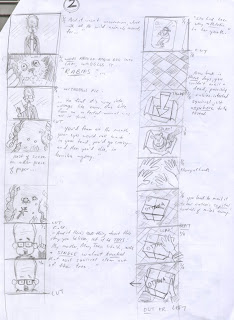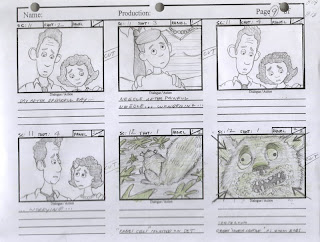It's a pretty tried and true process, I certainly didn't invent it. But there's a few personalized twists to the process, as you'll see.
You can click to make this bigger...

The above image was basically "Round 1" of the story development. I knew the story would feature a Narrator (me) who would introduce the story, and then pop back into the story, upon occasion. So I simply started writing the story out as if I was telling it to someone "live".
That's a method of storytelling I feel confident in (and in fact, everything I've made has a Narrator, in the first person). Different pieces I've made use that Narrator to a greater or lesser extent, but they all have a Narrator. I've always loved what a Narrator does to a story, the extra layer of character it offers. When every thing's being filtered through that character, there's a lot of tensions and juxtapositions that can happen. And there's an inherent intimacy that is created between the film and the audience, when someone speaks directly to YOU, the audience.
I know in part this is the result of my college training, that was very much influenced by Philip Hoffman.
His work is certainly more formal than mine, and operates within a more classical "Experimental" realm, and he's not an animator. So at first glance, you'd probably never see any connections between our work. After all, I make cute little puppet movies, that lightly touch on deeper things. He makes serious art house flicks that dig right into heavy, thought-provoking stuff.
But from him (and other faculty in the Media Arts Program at Sheridan, in the mid 1990s) I learned how powerful a personal, intimate approach to cinema can be, regardless of whether you're working in live action, documentary, interactive media, or animation. The film's content can be accessible, broadly appealing, easy on the eyes, traditionally narrative, and so on... but STILL be personally motivated and intimate in its approach.
I think I make stuff that grows out of the traditions honed by artists like Phil Hoffman, even though my stuff has rooted itself in a more commercial, broadly appealing form.
Anyway, moving on...
In an earlier posting, I said how lethal I thought doing all your story development via a word processor could be. If you check out the above scan, you'll see it's covered in very rough panels, arrows, scribbles, redirects, questions to myself, development notes, inserts... working this way was immediate and raw and real. And it always lets you see the process, how you got to where you are. When you see notes to yourself laid out right on the story, it points you to other parts of the story, it reminds you that perhaps there's motifs or story points that need picking up later in the story... and it all happens at a glance, right in front of you.
Even when you change your mind, and scribble something out, that remains on paper to remind you of the choice you made. And all this helps you grow the story. Well, it helps ME. It's a personal process that works for me, and I offer it here because seeing how others "do it" can help hone your OWN process.
I simply stapled all the papers together, and kept coming back to it as I developed it.
Then: below is "Round 2", which was a tightening of things from Round 1. It reads in columns, from top to bottom. At this stage, I guess it's basically the "Thumbnail" version of things. It takes into account the Voice Over, but more specifically depicts the visuals and how they will cut together. To start, I dash out a couple of columns, then start filling them in, with no mind to refining or keeping it clean. This is really about getting the visuals and audio to work together.
Click the pic to make it bigger...

And from this, it's a fairly boring step to "Round 3," which is tightening it up a lot, and putting it into formal storyboard panels.
Click the pic to make it bigger...

I call it fairly boring, because even though this stage is vital, the alchemy and the excitement of developing the story is essentially done. It reminds me of what an animator told me once of working with a director on project. The director would go over the shot with the animator, and together they'd build up great ways to stage the shot, dreaming up all the "goodness" that would go into the shot. This process would be filled with laughs, "what ifs," and real moments of creative storytelling excitment. Then the director would leave. And the animator would sigh, cause the FUN part was done. It was all dreamed up. Now, it was just about putting his head down and MAKING it. That's like this stage of boards. The fun is done, but not the work. And this stage of boards is work, for real.
With this final stage, it's about making it tight and clean and easy to reference when I'm shooting. It's these final boards that I put up on the studio wall, and use to reference when I shoot. These boards will have various production notes included, so that as I set up for the shot, the board reminds me of specifics. For example, a prop in this shot might appear in the board to be the same prop as in an earlier shot, but in fact, it needs to be altered somehow, for continuity.
So these boards have to be detailed, tight, easy to reference...but it's not creative. It's essential work, but not fun work. But in the end you've got a nice set of boards.
For me, Round 1 and 2 are so much fun, because they are so raw. Anything can happen at those stages, and there's an energy that lives in the rough panels that is inspiring. With Round 3's tight boards done, it's pretty locked in. But that's the way it goes. It's a necessary thing for story, it has to get tight. Effective production flow demands it.
With the tight boards done, I shot a still of each panel (I guess I could have scanned them instead, but it's easier for me to shoot stills with a video camera), and use those to create my leica reel, otherwise known as my animatic, or story reel (why they can't just call it one thing, I don't know, or care).
I refined the Voice Over on paper, then recorded it. This happened over several sessions, because I would cut some voice into the leica, sleep on it, and revise how I wanted it delivered. That's a luxury when you do your own voice work- re-recordes are easy to schedule!
Then I cut it all together with the storyboard drawing in Premiere (on my Mac), and thus concludes the story portion of the project. Of course, I spent quite a while editing the leica, getting the timing right, the flow of the whole thing... that's why you take the time at the stage, so that when you actually shoot you know exactly what you need from your shots.
So in the end, it followed a fairly traditional method of development for animation: rough story with sketches, leading to thumbnails, leading to tight boards, then animatic.

1 comment:
COOL MAN...this is all very exciting here.
jriggity
Post a Comment